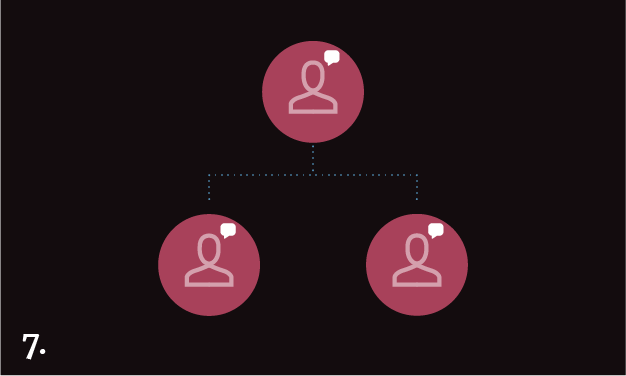 W
W
ho owns business growth at your organization? The principals? The sales team? A business development head? Whoever it is, chances are a select few among your team are focused on generating business opportunities while the rest focus only on delivery.
No doubt, the sales engine you have built is high-performing. Many sales managers would say, “We know what we’re doing. We have target- and ranked-prospect lists, CRM, reporting, and our marketing is top notch.”
Yet, if there were tools available to create additional opportunities or get a leg up on the competition, wouldn’t you use them? What if they already existed in your organization, with little incremental cost to use them?
The power lies in organizational collaboration.
Stop thinking about business development in silos
Too many organizations today operate business development as a stand-alone function. “I don’t want people talking to my clients,” a sales rep may say. “It’s a complex sale, and no one can sell it quite like I do,” says the principal of a small business. Yet, no matter how high-performing these silos become, they fail to tap into the relationships, knowledge, and influence that their entire organization can provide.
For example, a Fortune 1000 IT services vendor was struggling to gain insight into a key account. An important contract was up for renewal, but the competition was gaining ground. The client had gone silent. As staff members discussed the issue, they realized the vendor’s head of operations had a personal relationship with the client’s head of IT. The head of operations engaged and identified service issues that could have cost the vendor millions in lost business.
Sound familiar? Even in today’s uber-competitive climate, where businesses seek new data, strategies, methodologies, and tools to gain even the slightest advantage, we fail to tap into the power of our own organizations. As a result, we miss the opportunity to leverage our most important relationships—our employees, strategic partners, business colleagues, and clients—to help grow our business.
The Nine Pillars of Business Development Collaboration™
Most employees—especially those who are in some part compensated for business performance—will play an active role in business growth if asked. But after decades of helping businesses grow, we’ve learned, first, that most won’t ask and, second, most don’t know how to mobilize their employees.
The Nine Pillars of Business Development Collaboration is a methodology and set of tools that help organizations collaborate as a group, grow their networks and communities of influence, and drive additional business development growth.
Each pillar is designed to support this mission. Embracing just one can help you excavate more data to support new prospect introductions and, ultimately, more new client relationships. Embracing all nine will transform your organization into a powerful business development machine.

Business Development:
Embrace the idea that business development (the creation of long-term value) is an organizational mission, not an individual or functional one. Decide, as an organization, that you will empower your employees, strategic partners, and business colleagues by leveraging their combined networks of influence to grow your business and your organization. Break down silos, create systems, and address personnel or other obstacles that stand in the way.

Networks of Influence (NOI):
Popular business social media, such as LinkedIn and Twitter, offer the powerful potential to understand the relationships between an organization’s employees and its prospects.
For example, a mid-sized fintech company penetrated a major U.S. retailer after its head of business development noticed a midlevel employee engaging directly on Twitter with the prospect’s SVP of innovation, whom she had met at a conference. Effective NOI analysis can enable a company to request warm, trusted introductions into prospects.
Developing actionable and repeatable NOI tools will save time and generate more calls, meetings, presentations, proposals, and closes.

Community of Influence (COI):
Face-to-face interaction remains crucial to business development success. However, the internet and mobility have eliminated prospects’ need for such communication in many stages of the sales process. Thus, our reliance on communities, such as nonprofits, charities, and associations, is more important to bringing people closer together than ever before.
In fact, we see many examples of lasting business relationships built between individuals who serve together in some form of community. Understanding and cultivating your organization’s COI (e.g., by encouraging volunteerism and board leadership) will increase both influence and new business opportunities over time.

Prospect Relationship Maps (PRMs):
Leveraging relationship-building activities such as NOI and COI will increase the potential entry points into a number of prospect organizations. Developing a formal prospect relationship mapping (PRM) process for your prospects is a powerful account-based strategy.
Use PRMs as a business development management tool while you pursue prospect companies, their employees, websites, social media profiles, work history, community engagement, and more. Look at PRMs as a road map for continuing your business development into your targeted prospects.

Event Engagement Influence (EEI):
If we agree that networks and communities of influence are vital to connecting meaningful relationships, then understanding how events are drivers for these face-to-face connections is important. Would you ever go into a big game without a strategy or playbook? Of course not.
Pre-event, at-the-event and post-event action plans should be foundational to your event strategy. Make the effort to understand the community leadership of the people and organizations that will be at these events. Understand that what you do after the event is the most important aspect of gaining a return on your event engagement—now that everyone has something in common.

Social Media Best Practices:
Despite the ubiquity of social media, and the valuable data it can provide, few organizations have a clear strategy. But social media and business development are both about relationships. Identifying and cultivating areas of group social influence can create a powerful network effect.
For example, a Fortune 1000 technology company reversed its conservative social media policies and began training employees to use their social channels for personal and business benefit. As a result, the organization created an efficient and highly effective marketing channel and increased its reputation for thought leadership in several important areas.

Strategic Advisory:
The benefits of consultative selling are well documented. Your prospects have several challenges that can benefit from strategic advisory. You have several subject matter experts, data, and intellectual property at all levels of your organization. Developing a strategy for mining and delivering this expertise (in the form of an advisory board, strategic partner relationship, digital content, and marketing) adds value to your prospects on an ongoing basis.
Delivering this selflessly over time will result in a more important role with prospects and clients, better access to decision makers, and reciprocal data and intelligence to support your business.

Vertical and Horizontal Sectors:
Every business has vertical and horizontal perspectives, just as every company has clients who are positioned in an industry. As a provider, having an industry perspective with your clients is critical to business development.
Consider that your prospect list has similar industry positions to those of your clients. Leveraging your clients’ area of interest with your prospects makes good business development sense. Developing perspectives, whether your clients are in a vertical or horizontal position, will increase your relevance with them and open new prospect doors.

Globally Aware:
Every business that has a website is global. Certainly, if you have clients, many will have a global pursuit, whether they are importing or exporting goods and services or both. Having a global perspective should be foundational to your company culture. So leveraging your network and community of international influence makes good business sense now and in the future
.
Applying the Nine Pillars
Today’s always-on, uber-connected world forces us who think about business growth every day to acknowledge that business development, like so many other things, is no longer best managed in a silo. Each of our employees, colleagues, and partners has access to the same expertise, tools, and relationships that we do. And, frankly, some are much better at it than others. The Nine Pillars of Business Development Collaboration provide an actionable road map for taking advantage of this phenomenon.
Case Studies
The pillars are much more than simple conjecture. They are time-tested strategies developed over decades of real-world business development success. And a number of businesses small and large, today, are successfully implementing them.
Carol Pittman
Founder and CEO, RedKnot Resource Group (WBE)
“Community engagement has been a consistent, 10-year focus within our company, but despite our strong ties in the community, we were not leveraging those bonds to initiate business dialogue. We found mutual business opportunities existed, right alongside our mutual goals of making a difference. Also, given the specialized nature of third-party risk management, we wanted to expand our managed service in two new verticals, also heavily impacted by data and cyber risk security.
By using the Nine Pillars’ Vertical and Horizontal Sectors, we reframed the message from being centered on our expertise in the prospect’s specific vertical, to the benefits gained by our clients across multiple verticals. Drawing on the challenges we had resolved for our clients (accelerating the regulatory compliance time frame, scaling for growth, and enhanced risk monitoring), we shifted the paradigm from an industry-specific focus to a practice expertise focus, across multiple industries. The Nine Pillars of Business Development Collaboration has helped us think through our approach to capture new business in two new verticals in the last year.”
Vicki Flier Hudson, CPBA, CPDFA
Chief Collaboration Officer, Highroad Global Services, Inc.
“After 15 years in business, I was really starting to rethink the idea of networking. I no longer relished the thought of attending event after event handing out business cards. The Nine Pillars of Business Development Collaboration gave me a new way to connect in a more intentional way. Soon I was having meaningful individual meetings with potential partners, speaking at events those partners invited me to, and even having colleagues represent me at events I didn’t attend! And the best part? Helping those colleagues help others and get results.”
Eric Pittman
President, Vital Solutions, Inc.
“The Nine Pillars of Business Development Collaboration provides a framework for a more strategic approach to business development. The entire leadership team is now more engaged in selling, and the results have been more effective than our previous ‘traditional’ sales model. It’s a refreshing approach to business development.”

Uli Dendy
CEO, TrueLanguage
“Business development in the language services industry is a perpetual challenge. We need to engage closely with decision makers from the start to better determine what our prospects need and develop the most effective strategies for their multilingual outreach. And we can’t get there on email campaigns and sales calls alone. The Nine Pillars of Business Development Collaboration has brought us into more productive contact with our prospects and brought a number of clients to greater heights of global success through TrueLanguage.”
Shawn Brown
President and COO, Snap Tech IT
“The Nine Pillars of Business Development Collaboration has provided our firm with a road map for business development and given our team a common set of tools and terminology to use. Now, when a team member is speaking about NOI (Networks of Influence), we are all crystal clear on what they are communicating. As an example of how we are leveraging the nine pillars, I recently leveraged ‘Event Engagement’ and ‘Community of Influence’ to strategically meet several individuals at an event. Through post-event communications, as a result, I was asked to join the board of an organization I am interested in.”
Kyle Tothill
Managing Director, Partner, eHire
“The Nine Pillars of Business Development Collaboration construct helped us to break down a long-term strategy that drives continuous and sustainable business in a simple and manageable way. Many of the efforts that go into predictive business development can be nuanced and require long-term investments of time and treasure. This model allows us to pursue business development in a manageable and simple way.”
Randy Romanuax
Co-Founder and Chief Strategy Officer, Somedia Solutions
“When we started our company nearly 10 years ago, networking was a crucial part of our business plan. Implementing the Nine Pillars of Business Development Collaboration just last year has helped us grow our business, increase our network, and focus our energies on what was most important—not only for our team, but also for our clients, prospects, and colleagues.”
Richard Warner
CEO, Aware Force
“The cybersecurity business is growing fast, and organizations are urgently seeking effective solutions. But the challenge for vendors is that there are so many of us, buyers are overwhelmed. Making connections is difficult. At Aware Force cybersecurity for employees, we’ve learned to embrace the Nine Pillars of Business Development Collaboration to grow our business.
We lead with one pillar in particular: Community of Influence. In a competent, crowded field of vendors, how can you stand out from other organizations? By actively engaging with industry nonprofits and professional organizations. I learned early on from civic leaders that Atlanta may be a Top 10 city, but it’s still a small, well-networked town you must engage in. Being genuine about how we contribute our time and energy connects us with buyers in constructive, nonthreatening ways.”
Anne Gildea-Olt
Managing Partner–HR Consulting, Strategic HRM Solutions, LLC
“While working with leadership teams, I have the opportunity to observe the power and impact of organizational collaboration in business development. One very successful business unit I worked with focused on developing a strong industry perspective within its core vertical sector. The Nine Pillars of Business Development Collaboration’s seventh and eighth pillars are a great starting point for the same.
In addition to ensuring that all leaders were well versed in the target industry, they positioned themselves as thought leaders in that sector by holding a highly anticipated offsite event each year where they brought together customers, prospective customers, internal subject matter experts, and industry thought leaders to discuss industry trends.”
Jaymen J. Chavda
Attorney, Chugh firm
“Employees of a company are the ideal ambassadors for a company, regardless of whether their compensation is tied to business development. The Nine Pillars of Business Development Collaboration provides a detailed, yet understandable framework for new employees or seasoned veterans. For our firm, combining the collaborative Business Development (first pillar) between the law and the accounting firms, we leverage the combined networks of each separate office. In addition, being Globally Aware (ninth pillar) enhances our network from the United States to a global market.”
Aaron Tanenbaum
COO, Treehouse Holdings
“I have always been taught that people buy from people. We take this to heart at Treehouse Holdings and appreciate the power of leveraging one’s network of influence. As we strive to find new ways to enhance our sales and customer success infrastructure for each of our mature solutions under the portfolio, applying the Nine Pillars of Business Development Collaboration framework is proving to help increase our sales efficiency and customer adoption.
Embracing even a few of the pillars has enabled us to break out of traditional role-based functions and create a culture of transparency and collaboration to accelerate achieving our goals. We already leverage support tools (e.g., CRM) and accompanying processes that we have in place.
But implementing the Nine Pillars of Business Development Collaboration allows us to now maximize leveraging our most valuable asset: our people. Not only does this include empowering our internal teams to leverage their networks, but also finding ways to leverage the combined networks of our provider, payor, vendor, investor, partner, colleagues, friends, etc.”
